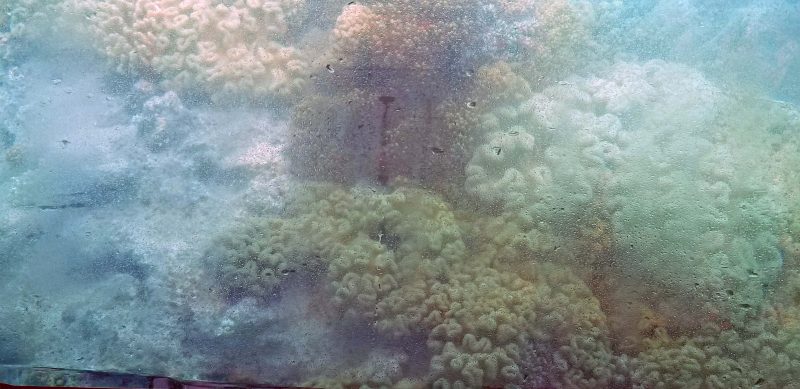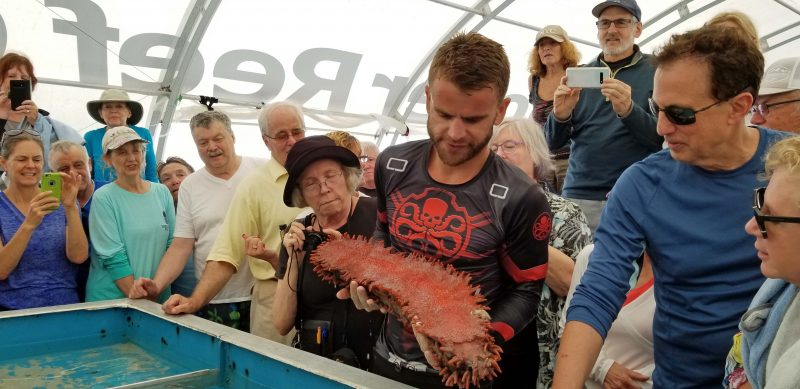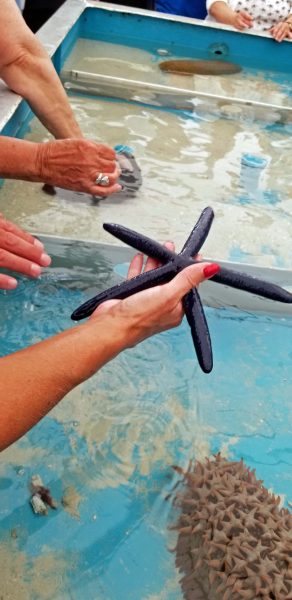For our visit to the Great Barrier Reef, our ship docked at Cairns, Australia. There were some Australians from Adelaide in line with us to leave the ship, so I asked them how to pronounce the city’s name. Well, it varies. The people in Adelaide are “free” (an Australian historical distinction) and they say something like “Can”; the rest of Australia pronounces it more like “Cane.” Either way, there’s no “s” sound, and they inject a very soft “r” into the word. It’s hard to duplicate if you’re not Australian.
The Great Barrier Reef, one of the seven natural wonders of the world and a UNESCO World Heritage Site, stretches 1,400 miles and is the largest continuous coral reef system on Earth. It can even be seen from space, and is home to about 1,500 varieties of fish, 360 kinds of colorful hard corals, and one-third of the world’s soft corals.
We’re in Queensland, which the license plates denote as “The Sunshine State” and where they average over 300 days of sunshine annually. Locals told us it hasn’t rained here for six months and it’s currently the dry season, but it rained all day today. There were some breaks in the showers, but no sunshine. It didn’t spoil our day, but the coral would have been more spectacular with sunlight shining on the water.
We took a catamaran out to the reef where we docked with a pontoon.

There were a dozen things to do on and from the pontoon, but even with a full day for this excursion (including 1.75 hours each way on the catamaran from the ship and back), there wasn’t time to try everything. Lunch was being set out when we arrived, so Ted and I walked around, checked things out, and decided to start with lunch while we were still dry, then go on to other things.
The glass bottom boat ride over the reef was one of our priorities, so we got in line for that. The line was long the entire time we were there, so it’s just as well we did that first.

We had a bit of luck during our ride because the rain stopped. The group just before us went out during a shower and said that the raindrops on the water’s surface made it very difficult to see the coral below. The colors would have been much prettier with the sun shining on the shallow water, but we saw some interesting coral formations.





Still in viewing mode, our next stop was the underwater observatory where we could see schools of tiny fish swimming by and get a close-up look at some coral. Coral is a living animal, so it sways and moves in the water. The coral in the second picture below was especially pretty as it fluttered underwater. The black and white striped fish is a (surprise!) zebra fish.



After that, a marine biologist gave a scheduled talk on some of the other marine life on the reef. The large, slug-shaped animal he’s holding is one variety of a sea cucumber.

Below is a different variety of sea cucumber. Its top and bottom sides look very different. We were allowed to touch it, and the star-shaped things on its back are very soft and a little mushy feeling. When you lift a sea cucumber out of the water, it releases sea water out of its bottom. (Third picture.) Tiny cleaner fish live in the sea cucumber’s bottom. I’ve heard of cleaner fish being used for pedicures–put your feet in the water and feel the tickles as the fish clean them. I haven’t tried that yet.



This is (obviously) a sea star. It looks black, but it’s really navy blue. We were allowed to touch it as well, and it feels like something firm (not hard) with a leather-like “sleeve” over it. Its legs moved slightly as it was being held, curling over a little bit on the ends.

The masseuse’s time was almost up and there were only two people in line, so that’s where we went next. Those who’d already had a massage repeatedly said how wonderful it felt and convinced us we should do this. The masseuse wore a toolbelt-like sack with some odd massage tools in it. One looked like a slingshot minus the sling and one looked like a chisel. Surprisingly, the chisel felt really good when he tapped it over tight muscles. It felt like the knots were being broken into tiny little pieces that dissolved.


We brought swimsuits along so we could snorkel, but the few people who did said that, due to the rain and the lack of sunlight, views of the coral were much better from the glass-bottomed boat. Stinger suits (black, tight-fitting head-to-toe garments similar to wet/dry suits) were issued to snorkelers to protect them from jellyfish bites. Even with the stinger suits, snorkelers said the water was very cool. Because of those comments, and because it was nearly time to leave, we passed on the snorkeling and took our dry swimsuits back to our stateroom. Maybe we’ll have another chance to snorkel at another beach on a sunny day. Here are a few snorkelers in action. And, of course, the next shower in the distance.

When we got back to the ship, we showered and changed into the required “casual elegant” clothing for dinner. In honor of Ted’s first summertime birthday today, we had advance reservations for dinner tonight at one of the two high-end restaurants onboard. At the maître d’s desk, Ted was greeted with a “Happy birthday, Mr. Schroeder” (pronounced “Schroder” of course) even though we didn’t tell anyone it was his birthday. I guess that’s included with our personal information for the cruise.
After we finished our main course, we were again surprised with a special dessert for Ted–a delicious chocolate mousse birthday cake topped with blueberries, his favorite fruit. It was far too much for the two of us, but they sent the remaining cake to our room, complete with plates, forks, napkins, and a knife. The leftover cake actually beat us to our room, where we also found a bottle of champagne chilling in the mini-fridge and two champagne flutes on the desktop. Happy birthday, Ted. It’s a destination birthday I’ll have trouble matching when it’s my turn.
